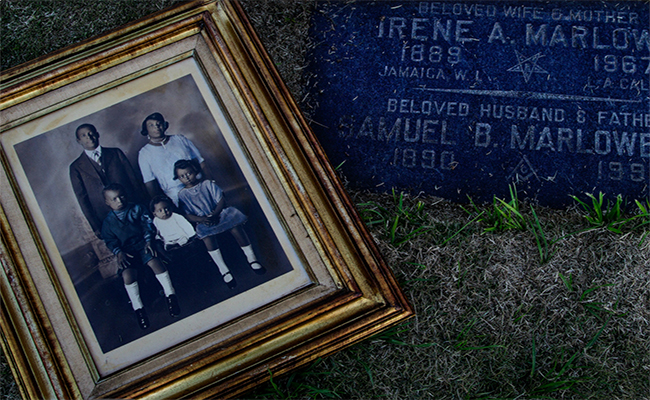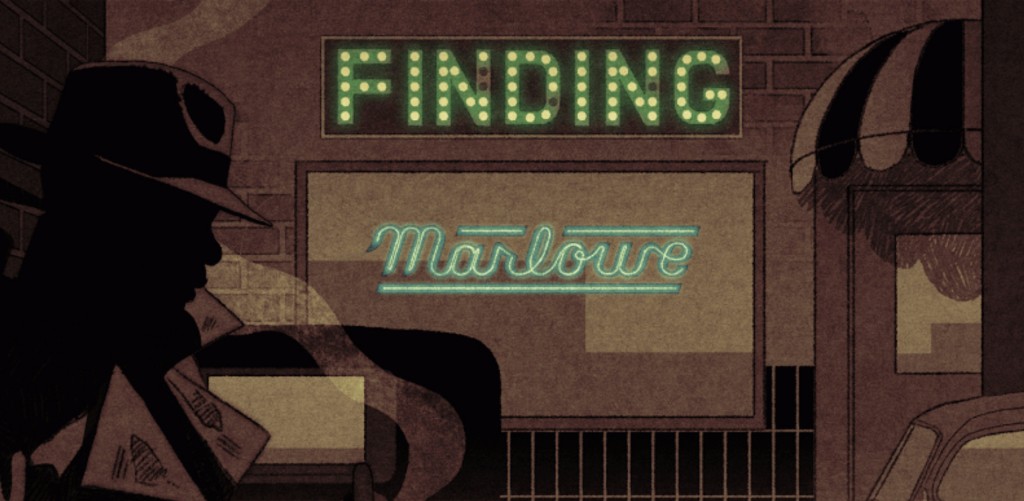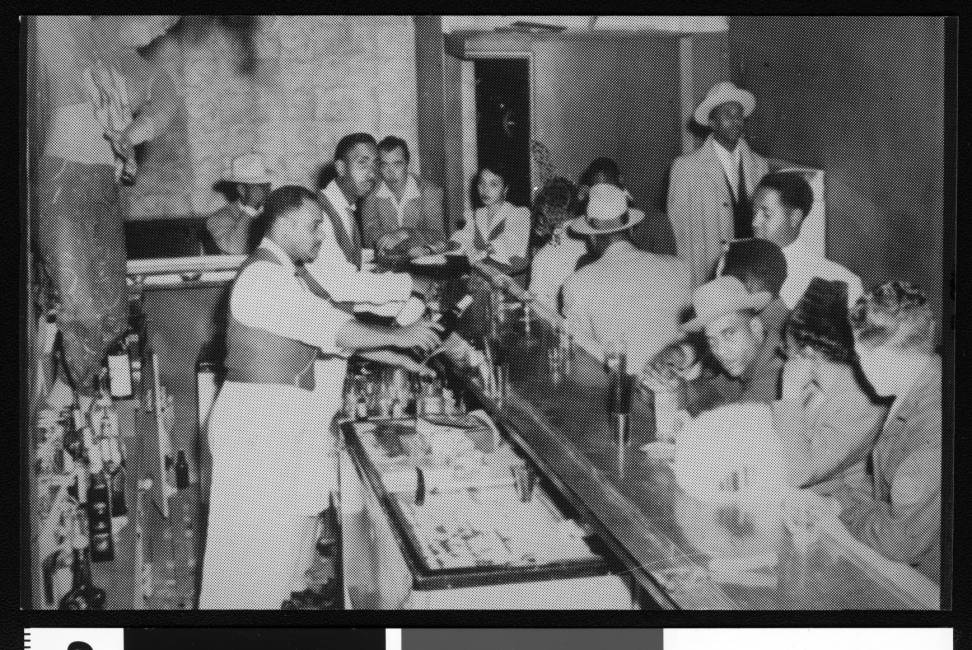
Samuel B. Marlowe (top left) appears in an undated family photo placed at his grave in Inglewood. | screenshot from latimes.com
The two most famous detectives of classic noir literature – Sam Spade and Philip Marlowe — just may have been inspired by the first Black private investigator licensed west of the Mississippi River – Samuel B. Marlowe. That’s according to a former Hollywood executive who brought Marlowe’s story to Los Angeles Times reporter Daniel Miller. In “Finding Marlowe” published last month, Miller attempts to trace just how much this Black private eye living in South Los Angeles in the mid-20th century shadowed lives throughout Hollywood.
According to Louise Ransil, the Hollywood executive, Marlowe corresponded frequently with legendary mystery writers Dashiell Hammett and Raymond Chandler, inspiring some of their characters and storylines. Think Sam Spade in Hammett’s “The Maltese Falcon” and Philip Marlowe in Chandler’s “The Big Sleep” — both books which became blockbuster films. And Chandler’s “Farewell, My Lovely” opens with a scene on Central Avenue, the African-American nightlife strip in South L.A. where Marlowe may have been hired to keep an eye on Hollywood actors out for some fun. Ransil believes Marlowe worked for Hollywood studios throughout the 1930s, 1940s and 1950s.
Though much evidence might point to Marlowe’s shadowy influence in Tinseltown, a significant amount of mystery still shrouds Marlowe’s life and work. The gumshoe died in 1991 at age 100, leaving relatives, studio execs and reporters to piece together his tale. Intersections South L.A. talked with Daniel Miller about researching the story and what he learned about South Los Angeles along the way.

Read “Finding Marlowe” on the L.A. Times website — complete with interactive, noir graphics. | latimes.com screenshot
Intersections: How did you discover this story?
Daniel Miller: My editor had a conversation with Louise [Ransil] and suggested that I have lunch with her. Just like the story says, we talked about what she had been working on and it was so fascinating that I decided to dig in.
In terms of building rapport with Marlowe’s family members, what was it like as a reporter to put yourself out there?
It was a great exercise in reporting and I really enjoyed it. I was a bit nervous when I knocked on the door of his nephew’s house. I had tried to get a hold of him, but I couldn’t. His phone was disconnected and I had written him and a letter or two but he hadn’t responded. I decided that this was the last ditch effort. I went over there, and luckily he answered the door and we ended up having a wonderful conversation.
How did you back up this story with proper sourcing?
It was a lot of research into organizations and companies — some of them defunct, some of them with poor archives. It was a lot of spade-work to try to verify some of that.
View a map of Marlowe’s haunts around Los Angeles:
View larger map on latimes.com
Just like Sam Spade himself. How did you use your background in entertainment reporting to aid you with this story?
I knew a bit about the movie business because I write about it most days. I suppose that gave me a bit of familiarity with parts of Marlowe’s life. Hollywood is the quintessential L.A. business. If you can write about Hollywood in an intelligent way, it helps you understand L.A. as a living, breathing place. Skills like that are certainly helpful in reporting on a person like Marlowe.
Why did you decide to write the story in first person? What were the discussions like with your editors?
It was a decision that involved many conversations and a lot of thought. Obviously it was a little unconventional for a newspaper, but we thought it was the best way to tell this story. Initially I didn’t set out to do it that way, but with the encouragement of several editors who worked on this with me we tried it and it seemed to work.

A look into Marlowe’s world: Club Alabam on Central Avenue next to the Dunbar Hotel opened in 1931 and featured Black entertainment for integrated audiences. | USC Digital Libraries via the Charlotta Bass/California Eagle Photograph Collection, Southern California Library
What kind of feedback have you received?
There’s no smoking gun, no treasure trove of information that helps you definitively say anything — but people are coming out of the woodwork. Which is great because the story is out there in the world now, and nobody knew about [Marlowe] previously. Now he’s out there in the world and people can do their own investigations and see what they make of it. And that’s kind of fun.
Had you read Dashiell Hammett and Raymond Chandler novels before diving into this story?
I took a class at UCLA on noir fiction and we read some of the greats — Hammett, Chandler and others. We read their books and watched the film adaptations of those books. It was a very unique way to look at how the story was treated on the page and then on the screen.
As an L.A. native, how did reporting this story change your impression of South L.A.?
I actually don’t know if my perception of [South] L.A. changed. I think that South L.A. has wonderful history. I’ve probably always believed that there were plenty of hidden gems like the Marlowe story that needed to be unearthed. So I was excited to help bring the Marlowe story out into the world, but I’ve done a little bit of reporting on South L.A. — so I knew there was a rich world I was diving into with South L.A., and I was excited to do it.
Like Intersections on Facebook, follow us on Twitter and sign up for the Newsletter to stay in the loop on news and views from South L.A. Email the author at [email protected] and follow her on Twitter at @jordynjournals.















Speak Your Mind